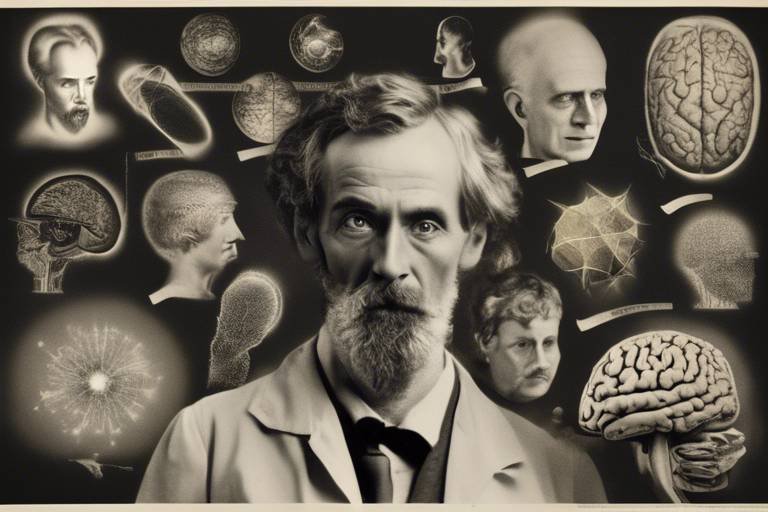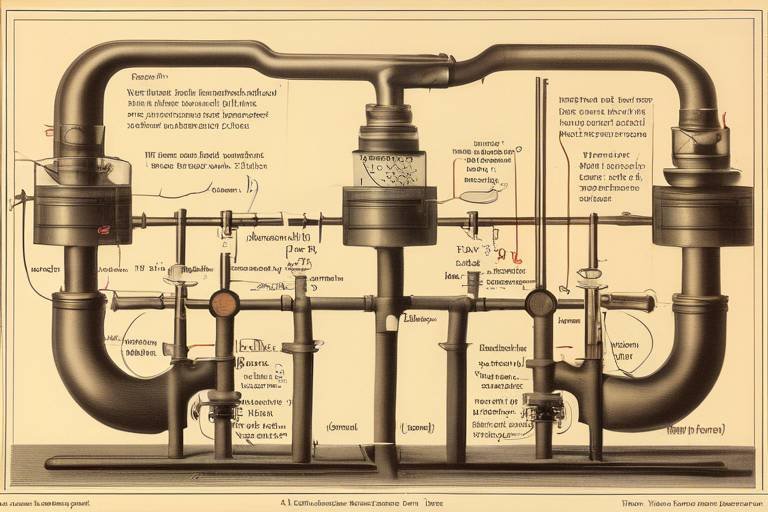Understanding Space-Time from Both Scientific and Philosophical Perspectives
The concept of space-time is one of those ideas that can leave you feeling both exhilarated and perplexed. Imagine a vast, interconnected fabric that weaves together the fabric of the universe, where every moment and every location is intricately linked. The exploration of space-time is not just a scientific endeavor; it is a journey into the very nature of reality itself. As we embark on this exploration, we will peel back the layers of scientific principles and philosophical interpretations that shape our understanding of this complex concept.
At its core, space-time combines the three dimensions of space with the dimension of time into a single four-dimensional continuum. This revolutionary idea, largely attributed to Albert Einstein, challenges our traditional notions of how we perceive the universe. Think of it as a cosmic stage where events unfold, not in isolated snapshots, but in a continuous flow of existence. This notion invites us to reconsider everything we thought we knew about motion, gravity, and the very essence of time itself.
The implications of space-time extend far beyond theoretical physics; they touch on the philosophical realms of existence, reality, and our place in the universe. How do we understand our experiences when the very framework of time appears to be fluid? What does it mean for something to exist in space-time? These questions have intrigued thinkers from various disciplines, leading to rich discussions that bridge science and philosophy.
As we delve deeper into this article, we will explore the scientific basis of space-time, examining Einstein's theories of relativity and their profound implications. We will also navigate through the philosophical interpretations that challenge our understanding of reality. Are space and time absolute entities, or are they merely constructs of our perception? This interplay between scientific inquiry and philosophical contemplation provides a fascinating lens through which we can view the cosmos.
Join us as we unravel the mysteries of space-time, a concept that not only defines the universe but also our very existence within it. Whether you are a science enthusiast, a philosophy buff, or simply curious about the nature of reality, this exploration promises to be a thought-provoking journey that will leave you questioning the world around you.
- What is space-time? Space-time is a four-dimensional continuum that combines the three dimensions of space with the dimension of time, forming the framework in which all physical events occur.
- How did Einstein contribute to our understanding of space-time? Einstein's theories of relativity revolutionized our understanding of gravity and motion, introducing the concept that space and time are interconnected and relative rather than absolute.
- What are the philosophical implications of space-time? Philosophically, space-time raises questions about the nature of reality, existence, and whether these dimensions are objective realities or constructs of human perception.
- Can we travel through time? While time travel remains a theoretical concept, discussions around it often explore the paradoxes and implications it would have on causality and our understanding of the universe.

The Scientific Basis of Space-Time
When we dive into the scientific foundations of space-time, we uncover a tapestry woven with the threads of Einstein's theories of relativity. These groundbreaking ideas revolutionized our understanding of the universe, challenging the very fabric of how we perceive space and time. Before Einstein, the prevailing view was that space and time were separate entities—like two parallel lines that never meet. However, Einstein's insights in the early 20th century transformed this notion, proposing that space and time are intricately linked in a four-dimensional continuum.
To grasp the essence of space-time, we must first understand the core principles of special relativity. Introduced in 1905, this theory asserts that the laws of physics remain constant for all observers, regardless of their relative motion. Imagine two trains racing along parallel tracks. If you're on one train, you may perceive the other as moving faster or slower depending on your speed. But according to special relativity, the fundamental laws governing their motion remain unchanged. This principle leads to mind-bending consequences, such as time dilation—where time can move at different rates depending on the observer's velocity.
In 1915, Einstein took these ideas further with his theory of general relativity, which describes how gravity affects the fabric of space-time. Picture a trampoline with a heavy ball placed in the center. The ball creates a dip in the surface, causing smaller objects to roll towards it. Similarly, massive objects like stars and planets warp space-time around them, influencing the motion of other objects. This concept not only explains how gravity works but also predicts phenomena such as the bending of light around massive bodies, a phenomenon confirmed during solar eclipses.
As we explore these scientific principles, we also encounter some fascinating implications. For instance, the concept of black holes emerges from general relativity. These regions of space-time possess gravitational pulls so strong that not even light can escape them. The very existence of black holes raises questions about the nature of space-time itself. Are they gateways to other dimensions, or do they signify the limits of our understanding? The mystery surrounding black holes challenges scientists and philosophers alike, prompting us to rethink our assumptions about the universe.
Moreover, the implications of space-time extend beyond theoretical physics. They influence cosmological models, including the Big Bang theory, which posits that the universe began as an infinitely dense point and has been expanding ever since. This expansion is not merely a movement through space; it is a stretching of the very fabric of space-time. In this context, time is not a constant; it is affected by the expansion of the universe, leading to intriguing questions about the nature of time itself.
In summary, the scientific basis of space-time is a rich and complex field that intertwines theoretical physics with profound philosophical implications. Understanding space-time requires us to embrace both the mathematical elegance of Einstein's equations and the awe-inspiring mysteries of the cosmos. As we continue to explore these concepts, we find ourselves at the intersection of science and philosophy, where the quest for knowledge becomes an adventure into the unknown.

Philosophical Interpretations of Space-Time
When we dive into the , we find ourselves navigating a complex landscape filled with intriguing questions and profound implications. It's not just a matter of physics; it's about how we perceive reality itself. Think about it: space and time are fundamental to our existence, shaping everything from our daily routines to our understanding of the universe. Yet, the way we interpret these concepts can differ dramatically based on philosophical viewpoints.
One of the most significant debates revolves around the nature of space-time itself. Is it an objective reality that exists independently of us, or is it merely a construct of human perception? This question leads us to two primary philosophical schools of thought: realism and anti-realism. Realists argue that space-time is a tangible entity that exists regardless of our observation, while anti-realists contend that our understanding of space-time is shaped by our experiences and perceptions. This fundamental disagreement influences how we approach everything from scientific inquiry to existential questions.
To illustrate, let's consider the implications of these views:
- Realism: If space-time is real, it implies a universe governed by laws that exist independently of human thought. This perspective supports the idea that scientific exploration can uncover objective truths about the cosmos.
- Anti-realism: Conversely, if space-time is a construct, it suggests that our scientific theories are merely models that help us navigate our experiences, not definitive truths. This viewpoint challenges the authority of scientific claims and opens the door to subjective interpretations of reality.
Another fascinating aspect of the philosophical discourse on space-time is the comparison between Newtonian and relativistic views. Newton's conception of space-time as absolute and unchanging laid the groundwork for classical physics. In this framework, space and time were seen as separate entities—a fixed stage upon which events unfolded. However, Einstein's theory of relativity shattered this notion, presenting space-time as a dynamic and intertwined fabric where the presence of mass and energy can warp and bend it. This revolutionary shift not only altered our scientific understanding but also invited philosophical inquiry into the nature of reality itself.
Furthermore, the implications of space-time extend into the realm of causality. How do we understand the sequence of events in our lives? In a relativistic framework, the relationship between time and causality becomes more complex. For instance, if time is not absolute, how do we define cause and effect? This leads us to ponder deeper questions about free will and determinism—are our actions predetermined by the fabric of space-time, or do we have the agency to shape our own destinies?
In summary, the philosophical interpretations of space-time challenge us to reconsider our understanding of reality. They urge us to reflect on the nature of existence, the structure of the universe, and our place within it. As we continue to explore these profound questions, we find that space-time is not merely a scientific concept but a gateway to understanding the very essence of being.
- What is the difference between realism and anti-realism in the context of space-time?
Realism posits that space-time exists independently of our perception, while anti-realism suggests that our understanding of space-time is shaped by our experiences. - How did Einstein's theory of relativity change our understanding of space-time?
Einstein introduced the idea that space and time are intertwined, challenging the classical view of absolute space and time. - What are the philosophical implications of time and causality?
The relationship between time and causality raises questions about free will and determinism, influencing our understanding of events and choices.

Newtonian vs. Relativistic Views
The debate between Newtonian and relativistic views of space-time is a fascinating journey through the evolution of scientific thought. Sir Isaac Newton, with his groundbreaking work in the 17th century, established a framework where space and time were seen as absolute entities. In his view, space was a vast, unchanging arena where events occurred independently of one another. Time, too, was a constant flow, ticking away uniformly, regardless of the circumstances surrounding it. This perspective allowed for a sense of predictability and order in the universe, akin to a well-oiled machine. However, as we ventured into the 20th century, a seismic shift occurred with the advent of Albert Einstein's theories of relativity.
Einstein proposed a revolutionary idea: that space and time are not separate entities but rather intertwined in a four-dimensional continuum known as space-time. This radical notion transformed our understanding of the cosmos, suggesting that the fabric of the universe could be warped and curved by mass and energy. Imagine a trampoline with a heavy ball placed in the center; the surface dips, illustrating how massive objects like planets and stars influence the flow of time and the trajectory of other objects. This was a stark contrast to Newton's rigid framework where such interactions were nonexistent.
To further illustrate the differences between these two views, let's consider a comparison table:
| Aspect | Newtonian View | Relativistic View |
|---|---|---|
| Nature of Space | Absolute and unchanging | Relative and dynamic |
| Nature of Time | Uniform and constant | Variable and affected by gravity |
| Interaction of Objects | Independent of one another | Interconnected through space-time |
| Effect of Mass | No effect on space or time | Curves space-time, affecting time flow |
This table succinctly encapsulates the fundamental differences between the two paradigms. For instance, in Newtonian physics, if you were to travel at a constant speed, time would pass the same for you as it would for someone standing still. However, Einstein's relativity tells us that if you were to travel close to the speed of light, time would slow down for you compared to that stationary observer. This brings us to a crucial point: the very perception of reality is altered based on the observer's frame of reference.
Moreover, the implications of these differing perspectives extend beyond theoretical physics; they ripple through our understanding of the universe itself. In a Newtonian world, the idea of time travel seems ludicrous, while in the relativistic framework, it opens up a realm of possibilities—albeit filled with paradoxes and challenges. This shift in thinking not only reshaped physics but also ignited philosophical discussions about the nature of reality, existence, and our place in the cosmos.
In conclusion, the transition from Newtonian to relativistic views marks a profound evolution in our understanding of space-time. It challenges us to reconsider what we perceive as reality and encourages an exploration of the universe that goes beyond mere observation. As we continue to unravel the mysteries of space-time, we find ourselves at the intersection of science and philosophy, where the questions become as intriguing as the answers.
- What is the main difference between Newtonian and relativistic views? Newtonian physics views space and time as absolute, while relativistic physics sees them as interconnected and relative to the observer.
- How does mass affect space-time? In relativity, mass can warp the fabric of space-time, affecting the flow of time and the motion of objects.
- Can we travel through time? Theoretical frameworks suggest possibilities for time travel, but they come with complex paradoxes and challenges.

Impact on Classical Physics
The advent of Einstein's theories of relativity marked a profound shift in the realm of physics, fundamentally altering our understanding of the universe. Before Einstein, classical physics, particularly Newtonian mechanics, dominated the scientific landscape with its neat and tidy equations. Newton's laws suggested a universe governed by absolute space and time, where objects moved in predictable paths, and time flowed uniformly, like a river. However, Einstein introduced a revolutionary perspective that challenged these long-held beliefs, suggesting that space and time are interwoven into a single continuum known as space-time.
This transformation was not merely academic; it had tangible implications for how we perceive reality. For instance, consider the concept of simultaneity. In the Newtonian framework, two events occurring at the same time are simultaneous, regardless of the observer's position. Einstein, however, demonstrated through his theory of special relativity that simultaneity is relative. This means that two observers, moving at different velocities, could perceive the timing of events differently. Imagine two trains speeding past each other; while one passenger sees a flash of light from a distant signal, the other may perceive it as occurring at a different moment. This realization shattered the notion of an absolute timeline, leading us to reconsider the very fabric of reality.
The implications of Einstein's theories extended beyond just our understanding of time. They also reshaped our comprehension of gravity. Newton described gravity as a force acting at a distance, a simple pull between masses. In contrast, Einstein proposed that gravity is a curvature of space-time caused by mass. To visualize this, think of a trampoline. When you place a heavy object in the center, the surface dips, creating a curve. Smaller objects placed nearby will roll towards the heavier mass due to this curvature. This analogy illustrates how massive bodies like planets and stars warp the space-time around them, influencing the motion of other objects—an elegant and far-reaching concept that has been confirmed through numerous experiments.
Additionally, the introduction of relativity paved the way for modern physics, inspiring new fields of study such as quantum mechanics and cosmology. The interplay between relativity and quantum theory has led to groundbreaking discoveries, including the understanding of black holes and the expansion of the universe. As scientists continue to probe the mysteries of the cosmos, the foundational shifts initiated by Einstein's theories remain ever-relevant, challenging us to rethink our place in the universe.
In summary, the impact of relativity on classical physics cannot be overstated. It not only challenged the established norms of Newtonian mechanics but also opened new avenues of inquiry that have profoundly shaped our scientific understanding. As we delve deeper into the cosmos, the principles of space-time will continue to guide our exploration, reminding us that the universe is far more complex and interconnected than we ever imagined.

Realism vs. Anti-Realism
The debate between realism and anti-realism in the context of space-time is not just a dry philosophical exercise; it’s a vibrant discourse that touches on the very fabric of our understanding of reality. At its core, realism posits that space-time exists independently of our perceptions. It suggests that the universe operates with its own set of rules, and our observations are merely reflections of an objective reality. Think of it like a stage play; the actors (us) are performing in a world (the universe) that exists regardless of whether we are watching or not.
On the flip side, anti-realism challenges this notion. It argues that space-time may not have an existence outside of our perceptions and cognitive frameworks. In this view, space-time could be seen as a construct of human thought, shaped by our experiences and interpretations. Imagine it as a mirage in a desert—something that appears real but is ultimately an illusion shaped by our minds. This perspective raises intriguing questions about the nature of existence: If space-time is merely a construct, what does that say about our understanding of the universe?
To further illustrate the differences between realism and anti-realism, consider the following table:
| Aspect | Realism | Anti-Realism |
|---|---|---|
| Existence of Space-Time | Independent of perception | Dependent on perception |
| Nature of Reality | Objective | Subjective |
| Implications for Science | Science discovers truths about an objective reality | Science constructs models based on human experiences |
| Examples | Newtonian physics | Quantum mechanics interpretations |
This philosophical tug-of-war has significant implications for how we interpret scientific findings. For instance, if we lean towards realism, we might view the laws of physics as universal truths that apply regardless of human observation. However, if we adopt an anti-realist stance, we might argue that these laws are merely useful tools for navigating our experiences, not definitive truths about the universe.
Furthermore, this debate extends into the realm of scientific inquiry. Realists may argue that the success of scientific theories in predicting phenomena reinforces the idea of an objective reality. In contrast, anti-realists might contend that the very act of observation alters the phenomena being studied, suggesting that our understanding is fundamentally limited. This leads to a fascinating inquiry: Are we ever truly able to grasp the essence of space-time, or are we forever trapped within the confines of our own perceptions?
Ultimately, the discourse between realism and anti-realism regarding space-time invites us to reflect on our own beliefs about reality. It challenges us to consider whether we are mere spectators in a grand cosmic play or active participants shaping the narrative of existence. As we delve deeper into the mysteries of the universe, these philosophical questions will continue to provoke thought and inspire exploration.
- What is realism in the context of space-time? Realism asserts that space-time exists independently of human perception and operates based on objective laws.
- How does anti-realism differ from realism? Anti-realism posits that space-time is a construct of human thought and is dependent on our perceptions and experiences.
- Why is the realism vs. anti-realism debate important? This debate influences our understanding of scientific theories and the nature of reality itself, prompting deeper philosophical inquiry.
- Can both perspectives coexist? Yes, many philosophers argue that elements of both realism and anti-realism can coexist, providing a more nuanced understanding of space-time.

Time and Causality
When we ponder the intricate relationship between time and causality, we step into a realm that challenges our understanding of not just the universe, but our very existence. Imagine time as a flowing river, where every moment is a drop that carries with it the weight of events, actions, and reactions. In this analogy, causality acts as the current, directing the flow of these drops and determining how they interact with one another. This interplay raises fascinating questions: Does time dictate causality, or is it the other way around?
To grasp this relationship, one must first understand that causality implies a sequence of events where one event (the cause) leads to another (the effect). This is where the fabric of space-time comes into play. According to Einstein's theory of relativity, time is not a constant; it can stretch and warp based on speed and gravity. This means that the sequence of events can be perceived differently depending on the observer's frame of reference. For instance, if you were to travel near the speed of light, you might experience time at a different rate than someone stationary on Earth. This leads us to ponder: if time can bend so dramatically, how can we be sure of the order of events?
Consider the famous thought experiment known as the grandfather paradox. Imagine you travel back in time and accidentally prevent your grandfather from meeting your grandmother. If this were to happen, you would never be born, which raises the question of how you could have traveled back in time in the first place. This paradox highlights the complexities of causality within the framework of time travel. Does the potential for time travel undermine our traditional understanding of cause and effect?
Furthermore, when we analyze the implications of space-time on causality, we encounter the concept of light cones. A light cone represents the path that light, emanating from a single event, would take through space-time. Events that lie within the light cone of a given event can be influenced by it, while those outside cannot. This visualization helps us understand that causality is inherently tied to the structure of space-time itself. The events that occur within the same light cone are causally connected, while those outside are not, reinforcing the idea that our understanding of causality is fundamentally linked to our perception of time.
To summarize, the relationship between time and causality is not merely a philosophical debate but a scientific inquiry that challenges our perceptions of reality. As we dive deeper into the realms of physics and philosophy, we find ourselves grappling with profound questions that have yet to be fully answered. How does our understanding of time shape our view of causality, and vice versa? The answers may not be clear-cut, but they certainly provoke thought and inspire further exploration into the mysteries of the universe.
- What is causality? Causality refers to the relationship between causes and effects, where one event leads to another.
- How does time affect causality? Time can influence the order and perception of events, especially when considering relativistic effects.
- What is the grandfather paradox? It is a hypothetical scenario that questions the implications of time travel on causality.
- What are light cones? Light cones are diagrams that represent the path light would take through space-time, illustrating causal relationships between events.

Implications for Cosmology
The concept of space-time is not just an abstract idea; it has profound implications for cosmology, the study of the universe as a whole. When we think about the universe, we often envision vast stretches of space and time, but these two elements are intricately linked in ways that challenge our understanding of reality. The framework of space-time allows cosmologists to describe the universe's structure, its evolution, and even its ultimate fate. Imagine space-time as a fabric that weaves together the cosmos, where every thread represents an event, a moment in time, or a location in space.
One of the most significant implications of space-time in cosmology is its role in the Big Bang theory. According to this theory, the universe originated from an extremely hot and dense state, expanding rapidly in a process we call cosmic inflation. This expansion is not just a movement through space; it is an expansion of space itself. The fabric of space-time stretches, carrying galaxies with it. This means that the distances between galaxies are not static; they are dynamic and influenced by the very nature of space-time.
Furthermore, the expansion of the universe leads to fascinating consequences. For instance, as galaxies move away from us, their light is redshifted, which means that we see them as they were in the past. This phenomenon is a direct result of the interplay between time and space, showcasing how our perception of the universe is shaped by the dimensions we inhabit. The farther we look into the universe, the further back in time we observe, making the cosmos a vast archive of history.
Another intriguing implication of space-time in cosmology is related to the concept of black holes. These cosmic giants challenge our understanding of both space and time. When matter collapses under its own gravity, it creates a region where the gravitational pull is so strong that not even light can escape. Inside a black hole, the traditional notions of space and time break down. For instance, as one approaches the event horizon, time appears to slow down relative to an outside observer. This leads to the notion that space-time is not a simple stage on which events occur; instead, it is a dynamic entity that can warp and curve under the influence of mass and energy.
Moreover, the implications of space-time extend to the study of the universe's ultimate fate. Cosmologists debate whether the universe will continue to expand indefinitely, eventually leading to a "Big Freeze," or if it will collapse back in on itself in a "Big Crunch." These scenarios are deeply tied to the nature of space-time and the forces that govern it. The expansion rate of the universe, influenced by dark energy, is a key factor in determining its fate, illustrating how the very structure of space-time is integral to our understanding of cosmological events.
In summary, the implications of space-time for cosmology are vast and complex. From the origins of the universe to the enigmatic nature of black holes and the fate of the cosmos, space-time serves as the foundation upon which our understanding of the universe is built. As we continue to explore these concepts, we may uncover even more surprising truths about the nature of reality itself.
- What is space-time?
Space-time is a four-dimensional continuum that combines the three dimensions of space with the dimension of time, allowing us to understand how objects and events are positioned and related in the universe. - How does space-time affect the universe's expansion?
The expansion of the universe is a result of the stretching of space-time itself, which causes galaxies to move away from each other over time. - What role do black holes play in our understanding of space-time?
Black holes challenge our traditional notions of space and time, demonstrating how extreme gravitational forces can warp the fabric of space-time. - Can we travel through space-time?
While time travel remains a theoretical concept, the understanding of space-time allows scientists to explore the possibilities and paradoxes associated with it.

The Nature of Black Holes
Black holes are perhaps one of the most intriguing phenomena in the universe, captivating both scientists and the general public alike. These enigmatic entities are formed when massive stars collapse under their own gravity, creating a point of no return known as the event horizon. Once something crosses this boundary, it cannot escape, not even light, which is why they are termed "black." But what does this really mean for our understanding of space-time?
To grasp the nature of black holes, we must first acknowledge their relationship with space-time. According to Einstein's theory of relativity, massive objects warp the fabric of space-time around them. Imagine placing a heavy bowling ball on a trampoline; the ball creates a depression, causing smaller objects to roll towards it. This is similar to how black holes create a gravitational pull that draws in surrounding matter. The more massive the black hole, the more pronounced the curvature of space-time.
Black holes come in various sizes, categorized primarily into three types:
- Stellar Black Holes: Formed from the remnants of massive stars after a supernova explosion, these black holes typically have a mass ranging from about three to several tens of solar masses.
- Supermassive Black Holes: Found at the centers of galaxies, including our own Milky Way, these giants can possess millions to billions of solar masses. Their formation remains an area of ongoing research.
- Intermediate Black Holes: These are less understood and thought to be the missing link between stellar and supermassive black holes, with masses ranging from hundreds to thousands of solar masses.
One of the most mind-bending aspects of black holes is their effect on time. As one approaches the event horizon, time appears to slow down significantly for the observer. This phenomenon is known as time dilation, and it raises fascinating questions about the nature of time itself. For someone falling into a black hole, they would experience time normally, but an outside observer would see their descent slow down until they seemingly freeze at the edge of the event horizon. This paradox challenges our conventional understanding of reality, making black holes not just cosmic vacuum cleaners, but also profound philosophical puzzles.
Moreover, black holes are not merely destructive forces; they play a crucial role in the formation and evolution of galaxies. The gravitational pull of supermassive black holes can influence the motion of stars and gas in their vicinity, shaping the structure of galaxies. This gravitational interaction leads to fascinating phenomena such as accretion disks, where matter spirals into the black hole, emitting intense radiation that can outshine entire galaxies.
In summary, black holes are not just voids in space but intricate components of the universe that challenge our understanding of physics and reality. They embody the intersection of science and philosophy, prompting us to rethink our concepts of time, gravity, and existence itself. As we continue to explore these cosmic mysteries, we inch closer to unraveling the profound implications they hold for our understanding of the universe.
- What happens if you fall into a black hole? Falling into a black hole would lead to spaghettification, where the immense gravitational forces stretch and compress objects into long, thin shapes.
- Can black holes be detected? Yes, black holes can be detected by observing their interaction with surrounding matter, such as the radiation emitted from accretion disks.
- Is it possible to escape a black hole? No, once something crosses the event horizon, it cannot escape the black hole's gravitational pull.

Time Travel Theories
Time travel has long been a tantalizing concept that has captured the imagination of scientists, philosophers, and science fiction enthusiasts alike. The idea of moving through time, much like we traverse through space, raises profound questions about the nature of reality and our understanding of the universe. What if we could visit the past or leap into the future? Would we be able to alter events, or would we merely observe them? These questions lead us into the fascinating world of time travel theories, where science and philosophy intertwine in intriguing ways.
At the heart of time travel theories is the concept of wormholes. These hypothetical passages through space-time could connect distant points in time and space, potentially allowing for travel between different eras. Picture a tunnel that links two separate locations—one in the present and another in the past. While wormholes are rooted in the equations of general relativity, their existence remains purely theoretical. Scientists like Kip Thorne have explored the mathematics behind these structures, suggesting that if they exist, they could be manipulated in ways that allow for time travel.
Another popular theory involves the idea of closed time-like curves. These are paths through space-time that loop back on themselves, enabling an object to return to its own past. Imagine a racetrack where, if you could find the right speed and trajectory, you could finish the race and end up back at the starting line, but at an earlier time. While intriguing, such curves also introduce complex paradoxes—like the infamous grandfather paradox, which questions what happens if you were to travel back in time and prevent your grandparents from meeting. Would you cease to exist? Or would the timeline somehow adjust to accommodate your actions?
Moreover, the concept of time dilation, a phenomenon predicted by Einstein’s theory of relativity, plays a crucial role in understanding time travel. According to this theory, time moves differently depending on the speed at which an object is traveling and the strength of the gravitational field it is in. For example, if you were to travel at speeds close to the speed of light, time for you would slow down compared to someone remaining on Earth. This leads to the possibility of future travel—in theory, a person could embark on a high-speed journey into space and return to find that more time has passed on Earth than for them, effectively allowing them to travel into the future.
While these scientific theories are fascinating, they also provoke philosophical inquiries about the nature of time itself. Is time a linear progression, or is it more like a vast landscape we can navigate? Some philosophers argue that time is an illusion, a construct of human perception, while others maintain that it has a tangible existence independent of our observations. This debate influences how we understand time travel and its implications for our reality.
In conclusion, the theories surrounding time travel not only challenge our scientific understanding but also provoke deep philosophical questions about existence, causality, and the very fabric of reality. As we continue to explore the mysteries of space-time, we may find that the answers to these questions are as complex as the universe itself.
- Is time travel possible? While time travel remains a theoretical concept, certain scientific theories, like wormholes and time dilation, suggest it could be possible under specific conditions.
- What are the implications of time travel? Time travel raises numerous philosophical and ethical questions, including the potential for altering past events and the nature of causality.
- Can we travel to the future? Yes, theoretically, traveling at high speeds can allow for time dilation, meaning one could experience less time than those remaining stationary.
- What is the grandfather paradox? This paradox questions the implications of traveling back in time and changing events that could prevent one's existence.
Frequently Asked Questions
- What is space-time?
Space-time is a concept that merges the three dimensions of space with the dimension of time into a single four-dimensional continuum. It’s a way of understanding how objects move and interact in the universe, especially under the influence of gravity.
- How did Einstein contribute to our understanding of space-time?
Einstein revolutionized the concept of space-time with his theories of relativity. He proposed that time is not a constant, but rather is affected by speed and gravity. This means that time can run differently depending on how fast you're moving or how close you are to a massive object.
- What is the difference between Newtonian and relativistic views of space-time?
Newtonian physics treats space and time as separate entities—absolute and unchanging. In contrast, Einstein's relativistic view combines them into a single framework where the fabric of space-time can be warped by mass and energy, leading to phenomena like time dilation.
- What are black holes and how do they relate to space-time?
Black holes are regions in space where the gravitational pull is so strong that nothing, not even light, can escape from them. They challenge our understanding of space-time by creating extreme conditions that can lead to time dilation, where time slows down significantly near the event horizon.
- Can time travel actually happen?
While time travel is a popular concept in science fiction, some theoretical frameworks in physics suggest it could be possible under certain conditions, such as near black holes or through wormholes. However, practical time travel remains purely speculative and raises paradoxes that are still debated by scientists and philosophers alike.
- What is the philosophical debate surrounding space-time?
The philosophical debate centers on whether space-time is an objective reality that exists independently of human perception (realism) or if it is merely a construct of our minds (anti-realism). Different thinkers have varying opinions on the implications of space-time for existence and reality.
- How does space-time affect our understanding of causality?
Space-time influences how we perceive cause and effect. In relativistic physics, the sequence of events can vary depending on the observer's frame of reference, which complicates traditional notions of causality and challenges our understanding of how events are linked in time.
- What are the implications of space-time for cosmology?
Space-time is fundamental to cosmology as it underpins theories about the universe's origin, its expansion, and its ultimate fate. Concepts like the Big Bang and the dynamic nature of the universe rely heavily on the principles of space-time.



















